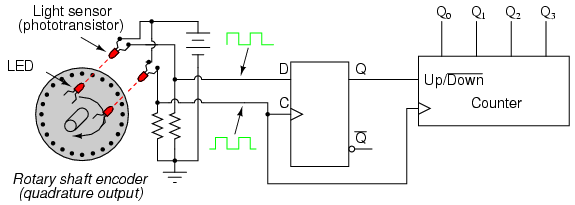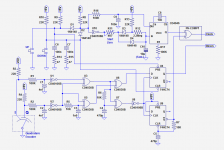Hi there,
Some time ago, I developed a remote controlled interface for one of my vintage frequency generators.
It is an excellent piece of equipment, and I love it very much, but the controls are archaic and unpractical, especially when you want to make frequency sweeps for instance.
Fortunately, it has BCD control inputs, allowing me to add a "modern" control interface, with a keyboard of course, but also with rotary encoders and up/down frequency controls for step by step control or sweeps.
In general, on most commercial equipments using variable rate up/down controls, the result is pretty disastrous: un-intuitive, too slow at some stage, much too fast at others, and globally anti-ergonomic and unpractical.
I have tried to make something smooth, pleasant and easy to use.
In addition, all the parameters can be individually adjusted if required, by changing the values of two or three components.
I thought this part of the interface could be useful to others, in many contexts, which is why I decided to share it.
The rotary decoder is a full 4x type, and it also includes debouncing.
The debouncer caps can be adapted to the exact encoder used (speed, steps, bounce, etc) by changing the values of C1 and 2.
The up/down controller, when properly adjusted, functions in a step by step mode with short actions on the up and down buttons, and then switches to a continuous, progressive mode if a button is held.
The two controls are seamlessly merged, and appear as a clock and a direction signal at the outputs.
The circuit is based on 4 ordinary CMOS ICs and can be built very cheaply.
It could be used to control digital potentiometers and similar subassemblies
Some time ago, I developed a remote controlled interface for one of my vintage frequency generators.
It is an excellent piece of equipment, and I love it very much, but the controls are archaic and unpractical, especially when you want to make frequency sweeps for instance.
Fortunately, it has BCD control inputs, allowing me to add a "modern" control interface, with a keyboard of course, but also with rotary encoders and up/down frequency controls for step by step control or sweeps.
In general, on most commercial equipments using variable rate up/down controls, the result is pretty disastrous: un-intuitive, too slow at some stage, much too fast at others, and globally anti-ergonomic and unpractical.
I have tried to make something smooth, pleasant and easy to use.
In addition, all the parameters can be individually adjusted if required, by changing the values of two or three components.
I thought this part of the interface could be useful to others, in many contexts, which is why I decided to share it.
The rotary decoder is a full 4x type, and it also includes debouncing.
The debouncer caps can be adapted to the exact encoder used (speed, steps, bounce, etc) by changing the values of C1 and 2.
The up/down controller, when properly adjusted, functions in a step by step mode with short actions on the up and down buttons, and then switches to a continuous, progressive mode if a button is held.
The two controls are seamlessly merged, and appear as a clock and a direction signal at the outputs.
The circuit is based on 4 ordinary CMOS ICs and can be built very cheaply.
It could be used to control digital potentiometers and similar subassemblies
Attachments
It is an Adret Type 2430.
It was very popular in Europe in the seventies, but it now seems to have sunk into complete oblivion, according to the www at least.
Note that the complete interface also includes counters, registers and various other items required to completely control the frequency, level and other functions remotely, but these details are useless to everyone, except if you happen to own exactly the same model.
On the contrary, the incremental part of the interface is very general and usable elsewhere.
What can be found on the net is typically a crap, simplified rotary encoder decoder like this one:

which doesn't do the full decoding and have no provision for alternate button-controls
Proper decoding can be performed using a µcontroller (but it requires constant attention from the µC), FPGA's, or specialized ICs like the ones made by Allegro for example, but these are rather costly, single-source options.
Getting away with a few inexpensive commodities is the kind of solution I favor: even in 20yrs time, you will have no difficulties finding spares
It was very popular in Europe in the seventies, but it now seems to have sunk into complete oblivion, according to the www at least.
Note that the complete interface also includes counters, registers and various other items required to completely control the frequency, level and other functions remotely, but these details are useless to everyone, except if you happen to own exactly the same model.
On the contrary, the incremental part of the interface is very general and usable elsewhere.
What can be found on the net is typically a crap, simplified rotary encoder decoder like this one:

which doesn't do the full decoding and have no provision for alternate button-controls
Proper decoding can be performed using a µcontroller (but it requires constant attention from the µC), FPGA's, or specialized ICs like the ones made by Allegro for example, but these are rather costly, single-source options.
Getting away with a few inexpensive commodities is the kind of solution I favor: even in 20yrs time, you will have no difficulties finding spares
- Status
- Not open for further replies.
